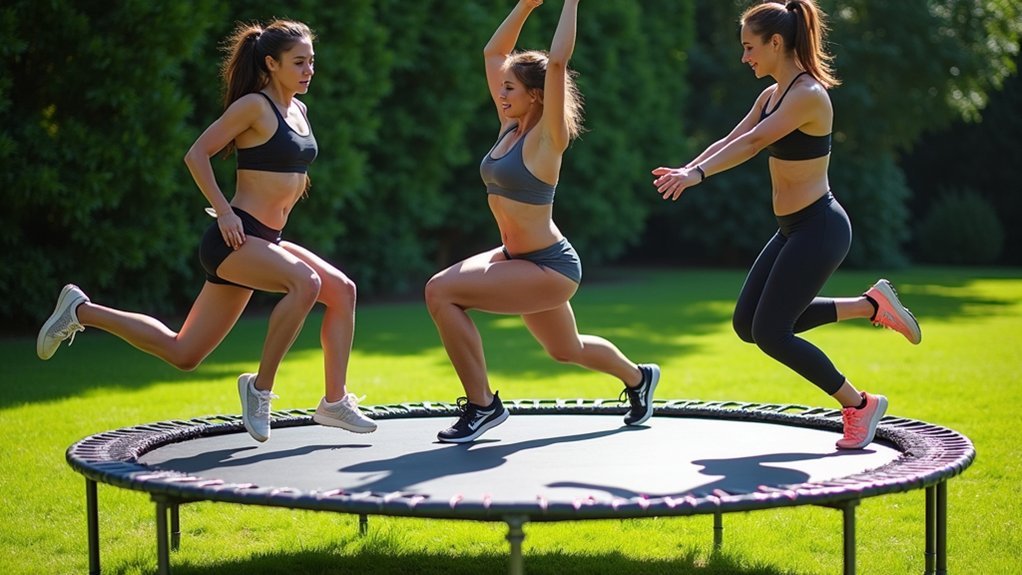For effective trampoline ab workouts: 1) Maintain a slight forward hip tilt and stay low rather than bouncing high to maximize core engagement. 2) Focus on controlled heel-driven bounces while keeping your upper body relaxed. 3) Exhale during downward movements to activate your transverse abdominis muscles. These techniques transform ordinary bouncing into a powerful core-strengthening routine that burns 150-250 calories per hour while reducing joint stress by 80%.
The Belly-Blasting Benefits of Trampoline Ab Engagement

While traditional ab workouts often leave you with sore joints and dwindling motivation, trampoline exercises transform core strengthening into an effective, enjoyable experience. Your body activates core muscles naturally with each bounce, engaging not just abs but your entire stability system.
Rebounding reduces joint stress by 80% compared to pavement exercise while still recruiting your full core muscle complex. The unstable surface forces deeper engagement as you balance, challenging proprioception and activating hard-to-target pelvic floor muscles. This simultaneous engagement is particularly effective for building a strong core since multiple muscle groups must work together during each jump.
Low-impact yet high-reward, rebounding engages your entire core while protecting joints and activating those hard-to-reach stabilizing muscles.
You’ll enjoy cardiovascular benefits alongside core strengthening, burning 150-250 calories hourly while boosting your metabolism. The vertical movement pattern stimulates lymphatic flow, enhancing detoxification and nutrient delivery to your core.
Best of all, the exercise-induced endorphin release makes you more likely to maintain consistent workouts.
Master the Perfect Bounce Technique for Maximum Core Activation
The foundation of trampoline core training lies in mastering proper bounce technique. Stay low with a slight forward hip tilt, focusing on heel-driven pressure rather than vertical height. Relax your upper body while maintaining rhythmic, controlled movements.
For greater intensity, widen your stance beyond hip-width or try single-leg presses to challenge stabilization. Incorporate isometric holds at the bottom of your bounce to increase time under tension. Remember to exhale during downward presses to maximize transverse abdominis engagement. Keep your jaws closed while breathing through your nose to maintain proper form during the entire exercise.
Avoid common mistakes like jumping too high, locking your knees, or slouching. These errors reduce core activation and increase injury risk.
Begin with seated bounces if you’re new to rebounding, then progressively add rotational movements and directional changes as your stability improves.
Time-Efficient Trampoline Circuit Combinations for Sculpted Abs

Maximizing your limited exercise time demands strategic circuit combinations on the trampoline. Implement 20-second work intervals with 10-second rests to maintain form while boosting metabolic demand.
Combine jack-knee hybrids with diagonal crunches to simultaneously target your rectus abdominis and obliques. Shift between plank-to-bounce sequences that pair static holds with dynamic rebounds for thorough activation.
For maximum efficiency, incorporate multi-directional movements like bowling-ball twist progressions and side-to-side shuffle hops that force your core to stabilize in the transverse plane. Add pulse jumps with lateral twists to maintain constant tension through micro-bounces. When performing these twists, remember to keep your core tight and open your chest as demonstrated in the single twist exercise.
When time is tight, try a 12-minute high-intensity ab blitz featuring seated knee lifts and cross-body knee drives that create contralateral tension across your abdominal fascia.
Frequently Asked Questions
Can Trampoline Workouts Help Reduce Lower Back Pain?
Yes, trampoline workouts can help reduce your lower back pain through their low-impact nature, core strengthening benefits, improved circulation, and increased spinal flexibility. You’ll experience less strain while building supporting muscles.
How Do I Prevent Foot Cramping During Extended Trampoline Sessions?
To prevent foot cramping during extended trampoline sessions, warm up with ankle circles and calf raises, stay hydrated with electrolytes, maintain proper foot positioning, and gradually build your session length to allow muscle adaptation.
Are Mini-Trampolines Safe for Postpartum Core Strengthening?
Mini-trampolines can be safe for postpartum core strengthening with proper modifications. You’ll need to start with gentle movements, keep bounces controlled, and wait for medical clearance. Avoid high jumps that strain your pelvic floor.
What’s the Difference Between Rebounding on Springs Versus Bungee Cords?
Springs give you a faster, bouncier rebound for intense workouts, while bungee cords offer a gentler, quieter experience with less joint impact. You’ll notice bungees provide softer landings but don’t maintain elasticity as long.
Can Seniors Safely Perform Trampoline Ab Exercises?
Yes, you can safely perform trampoline ab exercises as a senior. Use handlebars for stability, start with basic movements, and consult your doctor first. The low-impact nature is gentle on your joints.
In Summary
You’ll feel the difference in your core strength with these trampoline ab techniques. Remember to maintain proper form as you bounce, engage your midsection with every movement, and follow the circuit combinations for ideal results. Just 15-20 minutes three times weekly is enough to transform your abs. Your trampoline isn’t just for fun anymore—it’s your new secret weapon for a stronger, more defined core.





Leave a Reply